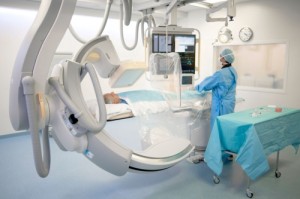 A study by Johns Hopkins researchers, titled “Substantial X-ray Dose Reduction in Intra-arterial Therapy for Liver Cancer: A New Angiographic Imaging Technology”, will be presented during the 100th annual meeting of the Radiological Society of North America (RSNA) in Chicago.
A study by Johns Hopkins researchers, titled “Substantial X-ray Dose Reduction in Intra-arterial Therapy for Liver Cancer: A New Angiographic Imaging Technology”, will be presented during the 100th annual meeting of the Radiological Society of North America (RSNA) in Chicago.
In this study, the team tested an interventional X-ray guidance device approved by the U.S. Food and Drug Administration back in 2013, and found that it has the potential to decrease radiation exposure in patients suffering from liver cancer undergoing intra-arterial therapy (IAT).
The team designed an ongoing prospective clinical trial to test Philips Healthcare’s AlluraClarity in 25 patients undergoing hepatic IAT, setting up a radiation dose structured reporting (RDSR) system that included air kerma (AK) and dose area product (DAP) for each run.
The radiation dose from the new AlluraClarity platform was compared to 25 other patients who underwent analogous procedures on Philips’s previous imaging platform (Allura).
The researchers observed that patients who used AlluraClarity had an 80% reduction in radiation exposure when compared to the Allura X-ray platform. Furthermore, the images produced by the new platform had the same quality as those produced by the standard system.
According to Jean-Francois Geschwind, M.D., a professor in the Russell H. Morgan Department of Radiology and Radiological Science in the Johns Hopkins University School of Medicine and its Kimmel Cancer Center, this platform could be beneficial for patients that need to preform therapy more than once; for children, since they are more sensitive to radiation exposure and for physicians who use these procedures on a daily-basis and become exposed to radiation.
[adrotate group=”1″]
To reduce radiation exposure, the power on common X-ray imaging platforms can be lowered. However, without any type of special image processing, the image distortion increases and physicians cannot detect the small structures necessary for an adequate treatment.
“You can compare this to an image taken with your cell phone in the evening without a flash,” Ruediger Schernthaner, M.D., a postdoctoral research fellow in vascular and interventional radiology at The Johns Hopkins Hospital explained in a press release.
The new AlluraClarity platform is equipped with a number of real-time image processing algorithms that allows it to attain high quality images using a lower radiation power.


